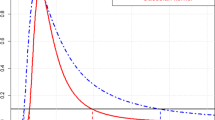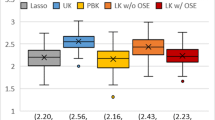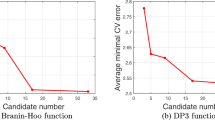Abstract
Surrogate modeling is commonly used to replace expensive simulations of engineering problems. Kriging is a popular surrogate for deterministic approximation due to its good nonlinear fitting ability. Previous researches demonstrate that constructing an appropriate trend function or a better stochastic process can improve the prediction accuracy of Kriging. However, they are not improved simultaneously to estimate the model parameters, thus limiting the further improvement on the prediction capability. In this paper, a novel penalized blind likelihood Kriging (PBLK) method is proposed to obtain better model parameters and improve the prediction accuracy. It improves the trend function and stochastic process with regularization techniques simultaneously. First, the formulation of the penalized blind likelihood function is introduced, which penalizes the regression coefficients and correlation parameters at the same time. It is a general expression and therefore can incorporate any type of penalty functions easily. To maximize the penalized blind likelihood function effectively and efficiently, a nested optimization algorithm is proposed to estimate the model parameters sequentially with gradient and Hessian information. As different regularization parameters can lead to different optimal model parameters and influence the prediction accuracy, a cross-validation-based grid search method is proposed to select good regularization parameters. The proposed PBLK method is tested on several analytical functions and two engineering examples, and the experimental results confirm the effectiveness of the proposed method.







Similar content being viewed by others
References
Audet C, Dennis Jr JE (2002) Analysis of generalized pattern searches. SIAM J Optim 13(3):889–903
Balabanov VO, Weckner O, Wu J (2014) Reducing error of polynomial approximation outside of designated design space for practical problems. In: 15th AIAA/ISSMO multidisciplinary analysis and optimization conference, p 2303
Byrd RH, Gilbert JC, Nocedal J (2000) A trust region method based on interior point techniques for nonlinear programming. Math Program 89(1):149–185
Chen S, Jiang Z, Yang S, Apley DW, Chen W (2016) Nonhierarchical multi-model fusion using spatial random processes. Int J Numer Methods Eng 106(7):503–526
Choi K, Jayakumar P, Funk M, Gaul N, Wasfy TM (2019) Framework of reliability-based stochastic mobility map for next generation nato reference mobility model. J Comput Nonlin Dyn 14(2):021,012
Dette H, Pepelyshev A (2010) Generalized latin hypercube design for computer experiments. Technometrics 52(4):421–429
Fan J, Li R (2001) Variable selection via nonconcave penalized likelihood and its oracle properties. J Am Stat Assoc 96(456):1348–1360
Forrester AIJ, Sóbester A, Keane AJ (2008) Engineering design via surrogate modelling: a practical guide. Wiley
Gramacy RB, Lee HK (2009) Adaptive design and analysis of supercomputer experiments. Technometrics 51(2):130–145
Haftka RT, Villanueva D, Chaudhuri A (2016) Parallel surrogate-assisted global optimization with expensive functions–a survey. Struct Multidiscip Optim 54(1):3–13
Hoerl AE, Kennard RW (1970) Ridge regression: biased estimation for nonorthogonal problems. Technometrics 12(1):55–67
Hung Y (2011) Penalized blind Kriging in computer experiments. Stat Sin 21(3):1171–1190
Joseph VR, Hung Y, Sudjianto A (2008) Blind Kriging: a new method for developing metamodels. J Mech Des 130(3):1–8
Kalnins K, Ozolins O, Jekabsons G (2008) Metamodels in design of GFRP composite stiffened deck structure. In: Proceedings of 7th ASMOUK/ISSMO international conference on engineering design optimization, association for structural and multidisciplinary optimization in the UK Bath. Citeseer, UK
Kennedy J (2010) Particle swarm optimization. Encyclop Mach Learn, 760–766
Kersaudy P, Sudret B, Varsier N, Picon O, Wiart J (2015) A new surrogate modeling technique combining Kriging and polynomial chaos expansions–application to uncertainty analysis in computational dosimetry. J Comput Phys 286:103–117
Li R, Sudjianto A (2005) Analysis of computer experiments using penalized likelihood in Gaussian Kriging models. Technometrics 47(2):111–120
Liang H, Zhu M, Wu Z (2014) Using cross-validation to design trend function in Kriging surrogate modeling. AIAA J 52(10):2313–2327
Lophaven SN, Nielsen HB, Søndergaard J (2002) DACE–a Matlab Kriging toolbox–version 2.0. Tech. rep., Technical University of Denmark
Mardia K, Watkins A (1989) On multimodality of the likelihood in the spatial linear model. Biometrika 76 (2):289–295
Martin JD (2009) Computational improvements to estimating Kriging metamodel parameters. J Mech Des 131(8):084,501
McIlhagga W (2016) Penalized: a Matlab toolbox for fitting generalized linear models with penalties. J Statist Softw 72(6):1–21
Nocedal J, Wright S (2006) Numerical optimization. Springer Science & Business Media
Ollar J, Mortished C, Jones R, Sienz J, Toropov V (2017) Gradient based hyper-parameter optimisation for well conditioned Kriging metamodels. Struct Multidiscip Optim 55(6):2029–2044
Palar PS, Shimoyama K (2017) On multi-objective efficient global optimization via universal Kriging surrogate model. In: In 2017 IEEE congress on evolutionary computation (CEC). IEEE, pp 621–628
Palar PS, Shimoyama K (2018) On efficient global optimization via universal Kriging surrogate models. Struct Multidiscip Optim 57(6):2377–2397
Park MY, Hastie T (2007) L1-regularization path algorithm for generalized linear models. J R Stat Soc 69 (4):659–677
Park C, Haftka RT, Kim NH (2017) Remarks on multi-fidelity surrogates. Struct Multidiscip Optim 55 (3):1029–1050
Sacks J, Welch WJ, Mitchell TJ, Wynn HP (1989) Design and analysis of computer experiments. Stat Sci 4(4):409–423
Sasena MJ (2002) Flexibility and efficiency enhancements for constrained global design optimization with Kriging approximations. PhD thesis, University of Michigan Ann Arbor
Schöbi R, Sudret B, Wiart J (2015) Polynomial-chaos-based Kriging. Int J Uncertain Quantif 5 (2):171–193
Schöbi R, Sudret B, Marelli S (2016) Rare event estimation using polynomial-chaos Kriging. ASCE-ASME Journal of Risk and Uncertainty in Engineering Systems Part A: Civil Engineering 3(2):D4016,002
Song H, Choi K, Lamb D (2013) A study on improving the accuracy of Kriging models by using correlation model/mean structure selection and penalized log-likelihood function. In: Tenth World congress on structural and multidisciplinary optimization. Orlando
Stickel JM, Nagarajan M (2012) Glass fiber-reinforced composites: from formulation to application. Int J Appl Glas Sci 3(2):122–136
Tibshirani R (1996) Regression shrinkage and selection via the lasso. J R Stat Soc 58(1):267–288
Toal DJ, Bressloff N, Keane A, Holden C (2011) The development of a hybridized particle swarm for Kriging hyperparameter tuning. Eng Optim 43(6):675–699
Viana FAC (2011) Surrogates toolbox user’s guide. Gainesville, FL, Version 3.0. https://sites.google.com/site/srgtstoolbox/
Viana FAC, Simpson TW, Balabanov V, Toropov V (2014) Metamodeling in multidisciplinary design optimization: how far have we really come? AIAA J 52(4):670–690
Waltz RA, Morales JL, Nocedal J, Orban D (2006) An interior algorithm for nonlinear optimization that combines line search and trust region steps. Math Program 107(3):391–408
Warnes J, Ripley B (1987) Problems with likelihood estimation of covariance functions of spatial Gaussian processes. Biometrika 74(3):640–642
Yu Y, Lyu Z, Xu Z, Martins JR (2018) On the influence of optimization algorithm and initial design on wing aerodynamic shape optimization. Aerosp Sci Technol 75:183–199
Zhang Y, Kim NH, Park C, Haftka RT (2016) Function extrapolation of noisy data using converging lines. In: AIAA Modeling and simulation technologies conference, p 2144
Zhang Y, Park C, Kim NH, Haftka RT (2017) Function prediction at one inaccessible point using converging lines. J Mech Des 139(5):051,402
Zhang Y, Yao W, Ye S, Chen X (2019) A regularization method for constructing trend function in Kriging model. Struct Multidiscip Optim 59(4):1221–1239
Zhao L, Choi K, Lee I (2011) Metamodeling method using dynamic Kriging for design optimization. AIAA J 49(9):2034–2046
Zhao L, Choi KK, Lee I, Gorsich D (2013) Conservative surrogate model using weighted Kriging variance for sampling-based RBDO. J Mech Des 135(9):091,003
Zhu Z, Du X (2016) Reliability analysis with Monte Carlo simulation and dependent Kriging predictions. J Mech Des 138(12):121,403
Zou H (2006) The adaptive lasso and its oracle properties. J Am Stat Assoc 101(486):1418–1429
Funding
This work is supported by the National Natural Science Foundation of China (Nos. 11725211 and 51675525).
Author information
Authors and Affiliations
Corresponding author
Ethics declarations
Conflict of interest
The authors declare that they have no conflict of interest.
Additional information
Responsible Editor: KK Choi
Publisher’s note
Springer Nature remains neutral with regard to jurisdictional claims in published maps and institutional affiliations.
Appendix
Appendix
The gradient and Hessian matrix of the negative profile penalized blind likelihood function are derived in the following. We first assume that the regression coefficients β and process variance σ2 are both fixed. Then, the gradient can be written as follows:
where e = y −Fβ, \(\dot {\mathbf {R}}_{j}=\partial \mathbf {R}/\partial \theta _{j}\), \(\dot {p}_{j}^{\mu }=\partial p^{\mu }/\partial \theta _{j}\), and tr(⋅) is the trace of a matrix. Furthermore, the Hessian matrix can be given as follows:
where \(\ddot {\mathbf {R}}_{jm}=\partial ^{2}\mathbf {R}/\partial \theta _{j} \partial \theta _{m}\) and \(\ddot {p}_{jm}^{\mu }=\partial ^{2} p^{\mu }/\partial \theta _{j} \partial \theta _{m}\).
Rights and permissions
About this article
Cite this article
Zhang, Y., Yao, W., Chen, X. et al. A penalized blind likelihood Kriging method for surrogate modeling. Struct Multidisc Optim 61, 457–474 (2020). https://doi.org/10.1007/s00158-019-02368-7
Received:
Revised:
Accepted:
Published:
Issue Date:
DOI: https://doi.org/10.1007/s00158-019-02368-7




